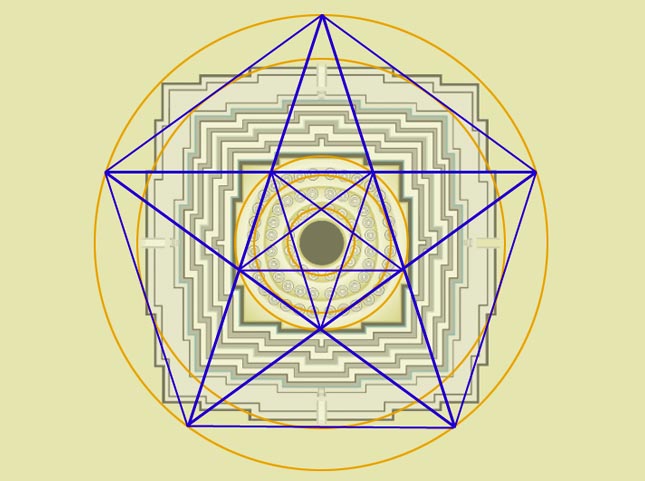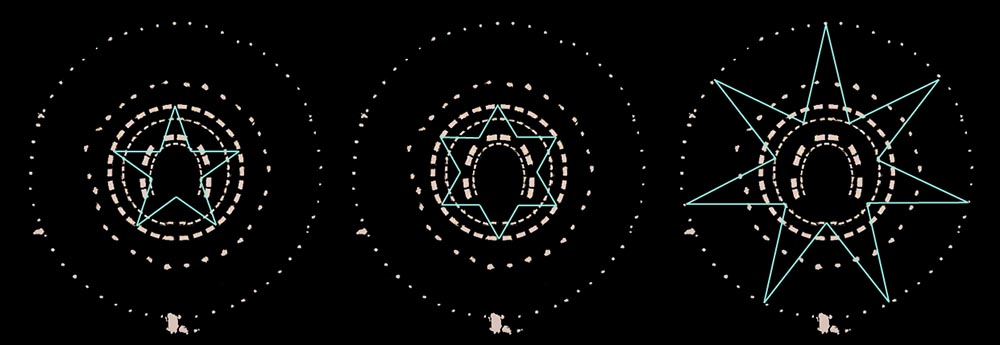THE SACRED GEOMETRY OF ANCIENT TEMPLES


Gaia-metry, or geometry is the measure of the Earth. In ancient times the relationship of the planets was discovered and applied to temples so that they were imbued with this cosmic order.
Gaia-metry, or geo-metry, is the measure of the Earth. As with other planets, the Earth was seen by ancient architects as an expression of a super-physical consciousness, the manifestation of spirit and of God: a living organism.
Since the temples were created as analogs of universal principles, designing them according to the same geometric proportions bound in the planet was to imbue the temple with soul. And so, just like the Earth, the temple was also regarded as a living organism.
The ancients figured out that the apparently physical world was constructed from atoms and molecules, and that each and every one was governed by patterns of order that favoured balanced geometric relationships, a view now held by modern physics.
Furthermore, by studying the heavens, and the orbits of planets in particular, the ancients deduced that each mean orbit related one to another in orderly geometric relationships. Since the planets were considered to be living bodies or akousmata (“resonant beings”) they were attributed the titles of Gods. And from that point, geometry became sacred.
The geometry of life – bio-geometry – was incorporated into the fabric of temples the world over. Much of it is occult (‘hidden from the eye’), and yet its presence can be felt by the atoms and molecules of the human body which are built on identical geometric platforms.
As the Greek philosophers used to say, to enter an ancient temple is to enter oneself is to know thy Self.
Some of the most celebrated uses of geometry are found in those deceptively simple buildings, the pyramids of Egypt. The Great Pyramid at Giza incorporates a most unusual slope angle of approximately 51.49º, which neatly references that only regular geometric figure, the seven-pointed heptagon. Unlike all other regular geometric figures, the heptagon is the only one whose angles cannot bisect a circle to a whole number, and so it has traditionally been associated with the unknowable, the seeking of wisdom, and of course, sound.
It has been described as the geometry of the soul.
The enigmatic Bent Pyramid at Dashur, often portrayed by orthodox archeologists as ‘a mistake’, is equally encoded with an invisible geometry, and an important one at that. When unfolded like the petals of a flower, the top slope angle reveals a pentagon, the bottom slope a hexagon.

Sacred geometry of Borobudur temple, Java.
This combination of geometries is inherent in the design of the crystalline structure of human DNA. Since biogeometry is an eddy of energy, or a material expression of consciousness, the energy field of a person walking into the Bent Pyramid is influenced by the actions taking place within that geometric framework.
The same effects are true in Gothic cathedrals and their complex geometry, Chartres being one of the finest examples. Russian scientists monitoring EEG brainwave patterns inside the nave of Chartres discovered that the building’s special harmonics have a noticeable affect on peoples’ states of awareness. When combined with Gregorian chant—the kind of music these churches were designed to amplify— brainwaves go up by as much as 4000% above normal waking state.
At Stonehenge, the relatively simple series of rings and horseshoes that make up the world’s most famous stone circle belie the fact that the positioning of the stones is governed by a complex geometric blueprint. In fact, it may be the only temple in the world that incorporates multiple sacred geometries: triangular, square, pentagonal, hexagonal, and heptagonal.
Stonehenge is the classic example of an organic temple, built and expanded over the course of 6000 years, serving to amplify the specific needs and subtle energy requirements of the era. Consequently, only parts of the temple were in use at any given ceremony: adepts would enter the temple with a specific purpose and consciously ‘awaken’ only those geometries that served the intent of the moment.
It is also worth noting that, when the temple is not in use or being misused, its subtle energy field shuts down. This is particularly so when thousands of tourists and their clicking cameras and camcorders are present, blissfully unaware of the true purpose of the site. Without the single-minded intent and respect, all that stands in front of them is nothing more than a bunch of upright, inanimate rocks.

Three of the sacred geometry relationships encoded into the rings and horseshoes of Stonehenge.
Thanks to a common framework in biogeometry, the energy exchange between the stone temple and the human temple only takes place whenever there is sympathetic resonance between the two. When the intent of the participants matches that of the temple with which they are interacting, a bond takes place, and such a connection often creates the conditions for shamanic states.
In our era, the new geometric temples are the enigmatic crop circles. Despite the vast amounts of money spent by special interest groups in debunking the subject, crop circles have been scientifically validated as a genuine phenomenon, and that it is intelligently guided to boot.
Like pyramids and Gothic cathedrals, genuine crop circles share the same occult geometric framework, and quite often the shape one sees in the flattened crop conceals a far different geometry. As with the Bent Pyramid, the crop circles favour the use of pentagonal and hexagonal geometry, and so it is not surprising that hundreds of documented cases describe alterations of awareness in people who interact with the designs, as well as healings. Indeed, sacred sites around the world share the same rich tradition.
It seems rather timely that, just as crop circles have sprouted in 29 countries, there has been a resurgence in interest in sacred sites. Wherever they manifest—from the fields of southern Britain to the prairies of Alberta and the rice paddies of Japan—the crop circles always do so beside ancient sacred sites. So it is more than wild conjecture that these new living organisms may beinfluencing the ancient temples that have fallen by thewayside for the better part of two thousand years, the only time in recorded history when we have stopped believing in the magic power of sacred space, even though modern technology is now capable of detecting the presence of subtle energy inside sacred places.
It seems the crop circles are waking part of our history and reminding us of a connection that needs to be rekindled.
Return to Sacred Geometry.
© Freddy Silva. No unauthorized reproduction.

Heptagonal framework governns the internal and external elements of the Great Pyramid of Giza.